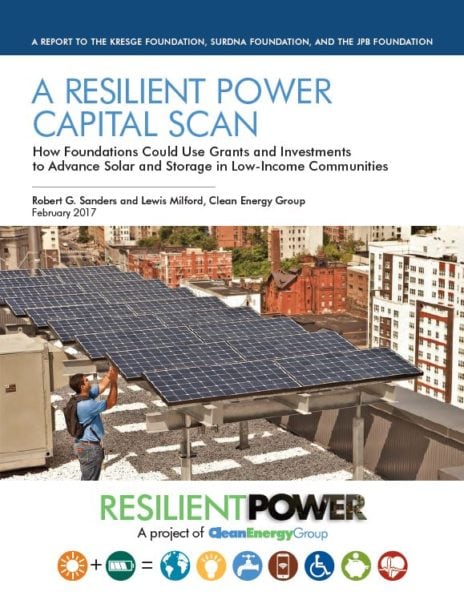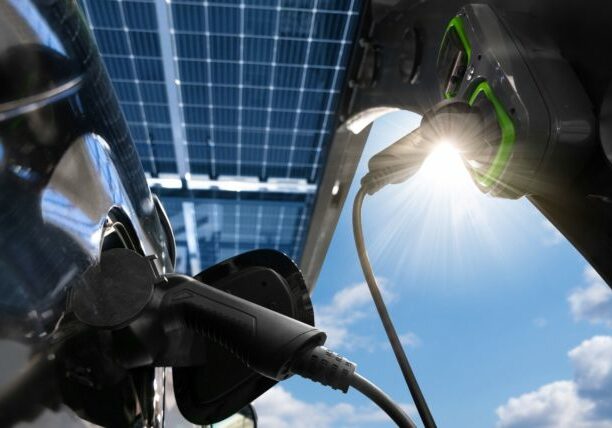February 2, 2017
Clean Energy Equity in 2017: How Foundations Can Advance Solar and Storage Technologies in Low-Income Communities
By Lewis Milford, Robert Sanders
At the end of 2016, the clean energy trade press was filled with upbeat stories about various renewable energy technology breakthroughs, cost reductions, and tipping points. But, if there’s one energy problem we did not solve last year, it is equity.
With all the progress made, we have failed to ensure that emerging new clean energy technologies such as solar and energy storage reach low-income communities, in both rural and urban areas. As in years past, clean energy companies are mainly marketing their innovations to commercial customers with the financial capacity to adopt new technologies for their economic benefits. Tesla and SolarCity come to mind. Those less well-off are still awaiting their turn, as they have for decades.
Hundreds of solar and energy storage projects were installed to reduce utility bills and provide energy resilience to companies or wealthy homeowners. But few were installed in affordable housing to provide benefits to low-income tenants; and few were done in community projects like food banks, police or fire stations, emergency shelters or schools to maintain critical services when grid power is disrupted. There were some bright spots, and many new projects are in the pipeline, but for the most part, the benefits of solar and energy storage have not trickled down to less affluent communities.
As we start a new year, we should ask ourselves several questions more forcefully:
- Why is the market not delivering clean energy to the poor and those in need—not only in hard-hit urban areas but in rural communities that feel left out of the economic recovery?
- How can that change in 2017, this new year that follows a year of political turmoil around economic inclusion, the haves and the have nots, and the role of government on climate change?
- How can we begin to bend the technology arc of technologies like solar and storage to benefit those most in need, all across the country?
- What is the market telling us about the barriers we need to overcome to reach the less well-off, so that we create a just transition to a clean energy future?
- Most importantly, where is change possible at the community and state level, and how can that be encouraged with more innovative investment by foundations?
To date, we had to rely on guesswork, anecdotes, and personal experience to answer these questions. There has been no systematic approach to identify the barriers keeping these technologies from reaching these underserved populations. In particular, there has been no empirically based effort for foundations to align their grant and investment strategies to accelerate the adoption of new technologies like solar and storage in low-income community projects and in affordable housing.
Three foundations have released a new report based on current market data, informed by extensive interviews with leading companies, advocates, foundation officials, and state and local policy leaders working in the solar and storage market. A Resilient Power Capital Scan: How Foundations Could Use Grants and Investments to Advance Solar and Storage in Low-Income Communities was prepared for The Kresge Foundation, Surdna Foundation, and The JPB Foundation by Clean Energy Group.
The report suggests a rigorous, comprehensive approach to bring clean energy to the poor, one that understands and harnesses the free market but also knows its severe limits in extending the benefits of new technologies to low-income customers.
For the report, Clean Energy Group conducted a series of interviews with over 30 experts in the solar and energy storage field—the first ever, deep empirical analysis of the challenges for the low-income market. The report presents a groundbreaking picture of where the market for solar and storage is now, and why it is not serving the low-income community as effectively as it serves high-end, commercial markets.
The Capital Scan found a series of major stumbling blocks, a set of structural market barriers, to deploy these technologies effectively in low-income markets. The results from these interviews are troubling, but not surprising.
Among these interrelated obstacles are the following:
- Barrier 1: There is a need for an integrated development finance model to overcome finance gaps in this underserved market.
- Barrier 2: There is a lack of internal capacity of portfolio owners, advocates, and public officials to develop solar and storage projects.
- Barrier 3: There is insufficient energy data collection, policy research, and economic analysis to understand how to advance technology development in these markets.
- Barrier 4: There is a need for additional capacity of technical services providers, project developers, and nonprofit intermediaries to reach low-income communities.
- Barrier 5: Finally, there are inadequate market rules, incentives, and regulatory policies to advance new solar+storage technologies in low-income markets.
For the most part, these barriers are common to all early technology markets. Start-up companies struggle to survive and compete, and project developers and financial institutions are reluctant to proceed without an extensive track record of performance and strong counterparty credit. In early technology markets, equity and inclusion are not the first thing on corporate minds.
In turn, policy makers, for their part, try to catch up and impose equity obligations, but too often it is after market rules have been created. At the same time, there is tremendous pressure on early stage companies from their investors to meet projections, deliver product, and capture market share wherever possible, but not to ensure that the least among us benefit as well.
Perhaps that is more a commentary on contemporary capitalism, but it is the real world. Foundations wanting change need to deal with the world that exists, rather than the one we would prefer exists.
So, to match these problems, the Capital Scan proposed that the foundation consider a series of specific real world solutions.
More than 50 interventions—ranging from grants to program related investments to endowment investments—are proposed in the report. It is designed to create a broad palette of options for foundations interested in different market efforts, ranging from investing in early stage and rapidly growing companies, to supporting the development of policies that create market rules and incentives that don’t exclude low-income communities, to building capacity in project developers and community organizations.
Among the proposed interventions that foundations can undertake are the following:
- Support New Tax Credit Aggregation Entity. There is a need for the creation of, outreach for, and initial administration of a new legal entity to aggregate multiple portfolio owners’ solar and storage tax credits to create a scaled investment opportunity for investors.
- Provide Credit Enhancement for Performance Risk. There is a need for credit enhancement
for investors and building owners to reduce technology and performance risk (e.g., “performance loss reserves” to reimburse monetary losses from unrealized economic benefits). - Provide Working Capital. Provide working capital to fund predevelopment costs and bridge the payment of developers’ fees that are often tied up in multiple projects.
- Provide Long-term Capital. Provide 10-year term capital to take out construction financing (preferably with a 15-year amortization) and as a capital source for on-bill payment programs.
- Create Online Project Software. Support the creation of an online software platform to assess the technical and financial feasibility of solar+storage in affordable housing and nonprofit-owned facilities.
- Fund Leadership Awards to Owners. Provide funding (“Leadership Awards”) to portfolio owners through nonprofit intermediaries for offsetting the organizational costs and new predevelopment costs of first-time solar+storage projects (e.g., technical and legal review, doc prep, assembling additional development team members, compliance, etc.).
- Invest for LMI Expansion. Invest in existing companies active in RP project development in the commercial space to expand reach into low- and moderate-income (LMI) community markets.
- Fund LMI Advocates. Provide funding to advocacy organizations to provide information and training to LMI residents on issues regarding resilient power with the goal of increasing LMI participation in policy discussions.
In the end, the report also is the beginning of what should be a long process of making amends in this field. For reasons complicated and defensible, climate advocacy has been on the knife’s edge, concerned more with meeting the climate emergency than ensuring solutions are equitably distributed. Given the threats and the entrenched opposition, such a “put out the fire” approach has been more than understandable.
However, the need for clean energy equity raises a new and fundamental challenge for climate advocacy and for foundations supporting it. The very nature of political support for climate solutions is now at stake.
From the right, the climate deniers and fossil fuel interests have laid out their unfortunate opposition. We know where they stand and how to fight back. Also, we face a new administration whose clean energy strategies seem unclear at best, a situation that seems to call on states and communities to do even more in the years ahead.
But the last thing we need is a parallel fight from the left, from those who believe that climate policies and clean energy support mechanisms are not fair and should not continue at all if they remain inequitable. Such an all-or-nothing approach could be catastrophic.
The response to both challenges is clear: foundations and advocates need to ensure that clean energy equity succeeds on its own merits, to create a more inclusive and just world. But there are other reasons to guarantee equity in this field. If clean energy support at the local and state level falls victim to fights over equality and equity, we will have undermined the best hope for solving the climate and clean energy problem. That would be a self-inflicted wound from which the environmental community—and the world—might not recover.
So to those multiple ends, the Capital Scan report is directed. To create new strategies for the poor to access the benefits from new technologies like solar and storage. To create new investment opportunities for foundations to create a just energy transition. And to shore up support for the key clean energy and climate policy programs needed to protect vulnerable populations and the planet.
The future needs all of these clean energy and equity strategies to succeed, and more. A lot is at stake to get this right. It is hoped that the Capital Scan report can be a contribution toward a more positive climate strategy for all.
***
This article was also published in Renewable Energy World.















